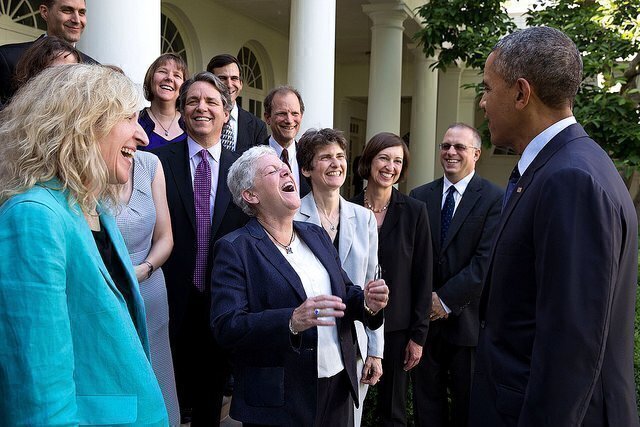
“Our climate is changing,” begins President Obama in a Facebook video announcing the final version of the Clean Power Plan—an ambitious effort to rein in carbon-dioxide emissions from power plants.
What’s not changing, however, is the fervent opposition to further government regulation. And that opposition is “champing at the bit,” as one federal judge put it, to challenge the Environmental Protection Agency’s latest action in court.
The new rule—proposed last summer and unveiled in a White House ceremony on Monday—is aimed at reducing nationwide emissions by 32 percent from 2005 levels by 2030. To achieve that reduction, states are assigned individual targets; they must submit custom plans to reach their targets by 2018 and actually meet those targets by 2022. If a state doesn’t comply, the EPA will impose a federal plan.
Furthermore, the rule calls for an increase in clean energy, requiring 28 percent of electricity to come from renewable sources by 2030. There are also various financial incentives for states to act early and fast, as well as for the creation of cap-and-trade systems that have proven toxic at the federal level.
Resistance to the proposal is deep and strongly felt.
“Once the EPA finalizes this regulation, West Virginia will go to court, and we will challenge it,” said Patrick Morrisey, the West Virginia attorney general, on Friday. “We think this regulation is terrible for the consumers of the state of West Virginia. It’s going to lead to reduced jobs, higher electricity rates, and really will put stress on the reliability of the power grid. The worst part of this proposal is that it’s flatly illegal under the Clean Air Act and the Constitution, and we intend to challenge it vigorously.”
The reaction is far from unexpected. In March, Senate Majority Leader Mitch McConnell of Kentucky sent a letter to all 50 state governors, explaining why and how they should resist the administration’s “war on coal.” Just days later, Harvard law professor and former Obama teacher Lawrence Tribe testified before Congress, where he accused the President of “burning the Constitution.”
And, of course, there were the lawsuits. Within two months of the plan’s proposal last year, two lawsuits were filed by Murray Energy, a private coal mining company, and a group of 12 states, respectively. The consolidated cases died in the D.C. Circuit, where a unanimous panel led by Judge Brett Kavanaugh declared that the plaintiffs “want us to do something that they candidly acknowledge we have never done before: review the legality of a proposed rule,” as opposed to one actually in effect.
Yet the complaints stand. Opponents of the Clean Power Plan contend that the EPA is abusing its authority under the Clean Air Act. They read the Act to prohibit the “double regulation” of an industry under Sections 112 and 111(d). The EPA, on the other hand, argues that the statutory interpretation is ambiguous and therefore is up to their discretion; they read the Act to allow the regulation a pollutant under Section 111(d) if it is not covered by Section 112.
Now that the rule has been finalized, fresh lawsuits are expected soon. Challengers may take comfort in the Supreme Court’s ruling in King v. Burwell, in which Chief Justice John Roberts asserted that the Court doesn’t have to defer to executive agencies in cases of “economic and political significance.” In other words, the ground has shifted, and the EPA may find a less-sympathetic Court the next time around.
“We certainly know how to defend against lawsuits, for crying out loud,” declared EPA Administrator Gina McCarthy at a press conference last month. We’ll see soon enough.







